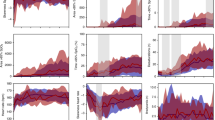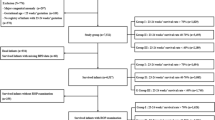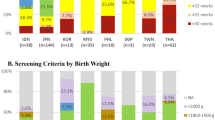Abstract
Background
Photobiomodulation by 670 nm red light in animal models reduced severity of ROP and improved survival. This pilot randomised controlled trial aimed to provide data on 670 nm red light exposure for prevention of ROP and survival for a larger randomised trial.
Methods
Neonates <30 weeks gestation or <1150 g at birth were randomised to receive 670 nm for 15 min (9 J/cm2) daily until 34 weeks corrected age. Data collected: placental pathology, growth, days of respiratory support and oxygen, bronchopulmonary dysplasia, patent ductus arteriosus, necrotising enterocolitis, sepsis, worst stage of ROP, need for laser treatment, and survival.
Results
Eighty-six neonates enrolled—45 no red light; 41 red light. There was no difference in severity of ROP (<27 weeks—p = 0.463; ≥27 weeks—p = 0.558) or requirement for laser treatment (<27 weeks—p = 1.00; ≥27 weeks—no laser treatment in either group). Survival in 670 nm red light treatment group was 100% (41/41) vs 89% (40/45) in untreated infants (p = 0.057).
Conclusion
Randomisation to receive 670 nm red light within 24–48 h after birth is feasible. Although no improvement in ROP or survivability was observed, further testing into the dosage and delivery for this potential therapy are required.
Similar content being viewed by others
Log in or create a free account to read this content
Gain free access to this article, as well as selected content from this journal and more on nature.com
or
References
Haddad, M. A. O., Sei, M., Sampaio, M. W. & Kara-Jose, N. Causes of visual impairment in children: a study of 3210 cases. J. Pediatr. Ophthalmol. Strabismus 44, 232–240 (2007).
Early Treatment for Retinopathy of Prematurity Cooperative Group et al.Final visual acuity results in the early treatment for retinopathy of prematurity study. Arch. Ophthalmol. 128, 663–671 (2010).
Larsson, E. K., Rydberg, A. C. & Holstrom, G. E. A population-based study on the visual outcome in 10 year-old preterm and full-term children. Arch. Ophthalmol. 123, 825–832 (2005).
Larsson, E., Martin, L. & Holmstrom, G. E. Peripheral and central visual fields in 11-year old children who had been born prematurely and at term. J. Pediatr. Ophthalmol. Strabismus 41, 39–45 (2004).
Larsson, E., Rydberg, A. & Holmstrom, G. E. Contrast sensitivity in 10 year old preterm and full term children: a population based study. Br. J. Ophthalmol. 90, 87–90 (2006).
Larsson, E. K., Rydberg, A. C. & Holmstrom, G. E. A population-based study of the refractive outcome in 10-year-old preterm and full-term children. Arch. Ophthalmol. 121, 430–436 (2003).
O’Connor, A. R. et al. Strabismus in children of birth weight less than 1701 g. Arch. Ophthalmol. 120, 767–773 (2002).
Section on Ophthalmology, American Academy of Pediatrics, American Academy of Ophthalmology, American Association for Pediatric ophthalmology and Strabismus. Screening examination of premature infants for retinopathy of prematurity. Pediatrics 117, 572–576 (2006).
Early Treatment for Retinopathy of Prematurity Cooperative Group. Revised indications for treatment of retinopathy or prematurity: results of the Early Treatment for Retinopathy of Prematurity Randomized Trial. Arch. Ophthalmol. 121, 1684–1696 (2003).
Dobson, V. et al. Visual acuity at 10 years in Cryotherapy for Retinopathy of Prematurity (CRYO-ROP) study eyes: effect of retinal residua of retinopathy of prematurity. Arch. Ophthalmol. 124, 199–202 (2006).
SUPPORT Study Group of the Eunice Kennedy Shriver NICHD Neonatal Research Network. Target ranges of oxygen saturation in extremely preterm infants. N. Engl. J. Med. 362, 1959–1969 (2010).
Askie, L. M. et al. NeOProM: Neonatal Oxygenation Prospective Meta-analysis Collaboration study protocol. BMC Pediatr. 11, 6 (2011).
Eells, J. T. et al. Mitochondrial signal transduction in accelerated wound and retinal healing by near-infrared light therapy. Mitochondrion 4, 559–567 (2004).
Oron, A. et al. Low-level laser therapy applied transcranially to rats after induction of stroke significantly reduces long-term neurological deficits. Stroke 37, 2620–2624 (2006).
Lampl, Y. et al. Infrared laser therapy for ischemic stroke: a new treatment strategy. Results of the NeuroThera Effectiveness and Safety Trial-1 (NEST-1). Stroke 38, 1843–1849 (2007).
Eells, J. T. et al. Therapeutic photobiomodulation for methanol-induced retinal toxicity. Proc. Natl Acad. Sci. USA 100, 3439–3444 (2003).
Albarracin, R., Eells, J. & Valter, K. Photobiomodulation protects the retina from light-induced photoreceptor degeneration. Invest. Ophthalmol. Vis. Sci. 52, 3582–3592 (2011).
Albarracin, R. & Valter, K. Treatment with 670-nm light protects the cone photorecptors from white light-induced degeneration. Adv. Exp. Med. Biol. 723, 121–128 (2012).
Albarracin, R. & Valter, K. 670 nm red light preconditioning supports Muller cell function: evidence from the white light-induced damage model in the rat retina. Photochem. Photobiol. 88, 1418–1427 (2012).
Qu, C., Cao, W., Fan, Y. & Lin, Y. Near-infrared light protects the photoreceptor from light-induced damage in rats. Adv. Exp. Med. Biol. 664, 365–374 (2010).
Eells, J. et al. Photobiomodulation for the treatment of retinal injury and retinal degenerative diseases. In Proc. Light Activated Tissue Regeneration and Therapy Conference. Lecture Notes in Electrical Engineering, Vol. 12 (eds Waynant, R. & Tata, D.) 39–51 (Springer, Boston, MA, 2008).
Liang, H. L. et al. Photobiomodulation partially rescues visual cortical neurons from cyanide-induced apoptosis. Neuroscience 139, 639–649 (2006).
Tafur, J. & Mills, P. J. Low-intensity light therapy: exploring the role of redox mechanisms. Photomed. Laser Surg. 26, 323–328 (2008).
Natoli, R. et al. 670nm photobiomodulation as a novel protection against retinopathy of prematurity: evidence from oxygen induced retinopathy models. PLoS ONE 8, e72135 (2013).
Albarracin, R. et al. 670 nm light mitigates oxygen-induced degeneration in C57BL/6J mouse retina. BMC Neurosci. 14, 125 (2013).
Kent, A. L. et al. A safety and feasibility study of the use of 670nm red light in premature neonates. J. Perinatol. 35, 493–496 (2015).
Khong, Y. T. et al. Sampling and definitions of placental lesions. Amsterdam Placental Workshop Group Consensus Statement. Arch. Pathol. Lab. Med. 140, 698–713 (2016).
ANZNN (Australia and New Zealand Neonatal Network). Report of the Australian and New Zealand Network 2008 and 2009 (ANZNN, Sydney, 2012). https://npesu.unsw.edu.au/sites/default/files/npesu/data_collection/Report%20of%20the%20Australian%20and%20New%20Zealand%20Neonatal%20Network%202012.pdf
Fitzgerald, M. et al. Red/near-infrared irradiation therapy for treatment of central nervous system injuries and disorders. Rev. Neurosci. 24, 205–226 (2013).
Mitchell, U. H. & Mack, G. L. Low-level laser treatment with near-infrared light increases venous nitric oxide levels acutely: a single-blind, randomized clinical trial of efficacy. Am. J. Phys. Med. Rehabil. 92, 151–156 (2013).
Al Rashoud, A. S., Abboud, R. J., Wang, W. & Wigderowitz, C. Efficacy of low-level laser therapy applied at acupuncture points in knee osteoarthritis: a randomised double-blind comparative trial. Physiotherapy 15, 242–248 (2014).
Kajagar, B. M., Godhi, A. S., Pandit, A. & Khatri, S. Efficacy of low level laser therapy on wound healing in patients with chronic diabetic foot ulcers—a randomised control trial. Indian J. Surg. 74, 359–363 (2012).
Mitra, S., Aune, D., Speer, C. P. & Saugstad, O. D. Chorioamnionitis as a risk factor for retrinopathy of prematurity: a systematic review and meta-analysis. Neonatology 105, 189–199 (2014).
Kim, C. Y. et al. Chronic placental inflammation as a risk factor of severe retinopathy of prematurity. J. Pathol. Transl. Med. 52, 290–297 (2018).
Ciner, E. B. et al. Stereoacuity of preschool children with and without vision disorders. Optom. Vis. Sci. 91, 351–358 (2014).
Ying, G. S. Sensitivity of screening tests for detecting vision in preschoolers-targeted vision disorders when specificity is 94%. Optom. Vis. Sci 82, 432–438 (2005).
Acknowledgements
This study was funded by the Canberra Hospital Private Practice Fund.
Author information
Authors and Affiliations
Contributions
A.K. conceived, developed and managed the study; analysed the results and prepared and finalised the manuscript; M.E.A.-L., B.S. and R.N. was involved in the conception of the study, analysed the results and approved the final manuscript; T.C. helped conceive the study, analysed the results and approved the final manuscript; MB was involved in the conception of the study, managed the study and approved the final manuscript; J.E.D. was involved in the conception of the study, assessed the placentas, analysed the results and approved the final manuscript; R.W.E. was involved in the conception of the study, performed the eye examinations, analysed the results and approved the final manuscript.
Corresponding author
Ethics declarations
Competing interests
The authors declare no competing interests.
Consent for publication
The mother of the patient gave consent for publication of Fig. 1.
Additional information
Publisher’s note: Springer Nature remains neutral with regard to jurisdictional claims in published maps and institutional affiliations.
Rights and permissions
About this article
Cite this article
Kent, A.L., Abdel-Latif, M.E., Cochrane, T. et al. A pilot randomised clinical trial of 670 nm red light for reducing retinopathy of prematurity. Pediatr Res 87, 131–136 (2020). https://doi.org/10.1038/s41390-019-0520-7
Received:
Revised:
Accepted:
Published:
Issue date:
DOI: https://doi.org/10.1038/s41390-019-0520-7
This article is cited by
-
Improvement in Central Serous Chorioretinopathy Following Multiwavelength Photobiomodulation Treatment – Case Report
Ophthalmology and Therapy (2024)



